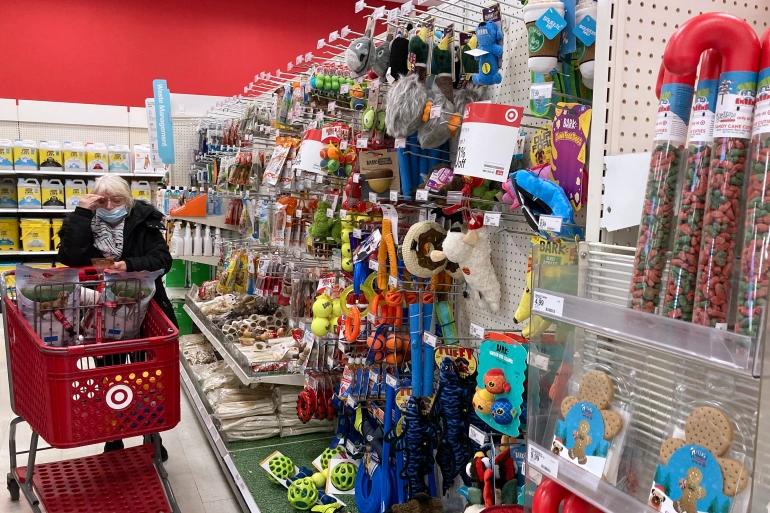US consumer prices increased 7% in December compared with a year ago – the sharpest 12-month spike since 1982.
Consumers in the United States could be forgiven for feeling as if they are stuck in an unpleasant time warp, with the latest government figures showing that inflation last month surged at its fastest annual rate in 40 years.
The Consumer Price Index (CPI), which measures price changes in a basket of goods and services, increased 7 percent in December compared with the same period a year ago, the US Department of Labor said on Wednesday. That is the sharpest 12-month spike since June 1982.
On a monthly basis, the CPI rose 0.5 percent in December after surging 0.8 percent in November.
Soaring inflation has become a hallmark of the US economic recovery, as supply chain snarls and shortages of materials and workers boost costs for businesses. Firms in turn then pass on at least a portion of those higher input costs onto consumers.
Inflation is especially tough on low-income households, which are seeing a larger share of their incomes consumed by rising prices, especially for essentials like food, fuel, and shelter.
A very concerning pressure point is soaring rent, which along with prices for used cars and trucks were the biggest contributors to December’s CPI surge.
On a brighter note, while food prices increased 0.5 percent last month, they rose less sharply than in previous months. And prices for natural gas – which nearly half of US households rely on as their primary heating source – fell, along with prices for petrol, ending a long run of increases.
Strip out food and energy, which tend to be CPI’s most volatile components, and the so-called core index rose 0.6 percent in December, after increasing 0.5 percent in November.
Over the last year, core CPI increased 5.5 percent last month – the sharpest annual rise since 1991.
Inflation and interest rates
Inflation is running so hot that late last year, the US Federal Reserve pivoted away from keeping borrowing costs low to get Americans back to work and towards reining in soaring price pressures.
During its last policy-setting meeting, the Fed said it was accelerating its tapering of bond purchases – which promote job growth but fuel inflation by keeping long-term borrowing costs low – and pencilling in at least three inflation-cooling interest rate hikes this year.
A little bit of inflation is a good thing because it keeps the economy humming along by enticing consumers to not put off purchases. That is hugely important because consumer spending drives some two-thirds of US economic growth.
But too much inflation is decidedly bad, because if prices spiral upwards, and crucially – consumers expect them to keep soaring – it could lead the Fed to hike rates more aggressively than anticipated and deliver a gut punch to the economic recovery.
During his confirmation hearing on Tuesday for a second term as Fed chairman, Jerome Powell said he and his fellow policymakers do see inflation abating by the middle of this year. But he also reassured senators that if the Fed sees “inflation persisting at high levels longer than expected”, it will take action.
“If we have to raise interest rates more over time, we will,” he said, adding that “high inflation is a severe threat to the achievement of maximum employment and to achieving a long expansion that can give us that.”
Meanwhile, the US jobs market recovery is staying on track. While the economy added a disappointing 199,000 jobs in December, the nation’s unemployment rate edged down to 3.9 percent as it closes in on its pre-pandemic level of 3.5 percent.
A near-record number of job openings has led businesses to sweeten pay and benefits packages to court scare job seekers. In a measure of how confident workers feel about their employment prospects, they are quitting their jobs in record numbers – often to take higher-paying positions.
That has reflected in average hourly earnings for all workers, which increased 4.7 percent in December from the same period a year ago.
Source: Al Jazeera


